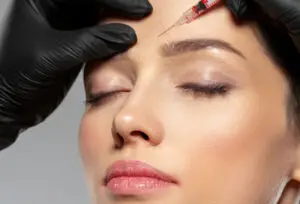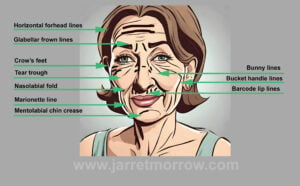In recent years, full, luscious lips have become the trademark of influencers, celebrities, and models. Whether it’s with lip fillers, overlining the lips with lip liner, or plumping serums, women (and men) around the world are doing everything they can to achieve the perfect lip ratio.
However, not all lips are created equal. With celebrities like Kylie Jenner, Angelina Jolie, and Taylor Swift taking the spotlight, most women are looking to achieve more prominent lips—regardless of how well bigger lips will match their facial features. While we all long for the picture-perfect look that has taken over our Instagram feeds, it’s important to understand the ideal lip ratio before going under the needle.
The Perfect Lip Proportions, According to Science
While Kylie Jenner and Amber Rose have iconic pouts, research has determined the exact measurements of the ideal lip ratio. Surprisingly, the Kardashian-Jenners are not at the forefront of the perfect lip trend. According to scientists from the Kirkkale University’s Faculty of Medicine, the ideal lip ratio is closer to the proportions of Kate Beckinsale and Mila Kunis1.
Professor Muluk notes that this ratio should be found in the width of the nose and mouth, as well as the distance between the pupils to the chin compared with the hairline to the pupils. Moreover, according to Muluk, “sausage” or “duck” lips do not merely occur from over-correction during lip injections or surgical procedures, but also stem from a poor understanding of normal human lip anatomy.
The golden ratio, denoted by the symbol phi, is a number that approximates to 1.618—at least those are the numbers that I remember. As an irrational number, like pi 3.14…, it goes on and on in no discernable pattern. The golden ratio’s importance is that it’s believed to hold the secret to beauty in aesthetically attractive proportions of the face. For example, the ideal ratio of the width of your nose to month is the width of your nose times phi. Another example is that the ideal distance between your pupils to your chin is phi x the distance of your pupils to your hairline. The ideal width of your eyes (at the lateral canthus) is phi x the width of your mouth.

From a Horizontal View of the Face:
Based on the golden formula, the top lip should extend no more than 3.5 mm, and the bottom lip should not extend more than 2.2 mm (from an imaginary line from the subnasion (SN) to the pogonion [POG]—see diagram above). To put this in simpler terms, 2.2 x phi = 3.5.

From the Front View of the face:
According to lead researcher Professor Nuray Bayar Muluk, the ideal lip projections reflects the “golden ratio” or “divine proportion”—1:1.618. This translates to the top lip being smaller than the bottom lip in height or slightly less than a 40:60 ratio. The lip depicted in this picture has a different ratio of 0.45:0.55.
What Is the Most Attractive Lip Ratio?
While studies have revealed the perfect lip proportions according to science, the most attractive lip ratio is not always in line with these findings. In part, the appearance of the lips plays an important role in the overall attractiveness of a person’s face. In general, women with fuller lips and greater vermillion height (the space between your lip tissue and normal skin) relative to their facial width are considered more attractive.
According to a 2017 study by JAMA Facial Plastic Surgery, an upper to lower lip ratio of 1:2 is considered the most attractive2. Believe it or not, bigger isn’t always better—and these findings reflect the proportions typically found in human anatomy. The study found that lips that were big, but not overly big, were ranked most attractive by both male and female respondents.
Meanwhile, in a 2017 study published by the Journal of Cranio-Maxillofacial Surgery, researchers found that an upper to lower lip ratio closer to 1:1 was considered the most attractive3. These findings are more consistent with recent trends in cosmetic medicine, with many clients aiming for a fuller upper lip.
Choosing the Best Proportions for Your Face Shape
Over the last decade, lip augmentation has become one of the most popular cosmetic procedures, with clients looking to achieve full, luscious, beautiful lips. Even if you’re looking to achieve prominent lips or a more dramatic pout, it’s important to keep in mind that your ideal lip shape will vary depending on your facial structure.
The lips are an integral component of the overall symmetry and aesthetics of your face, and achieving natural-looking results requires careful consideration of your other features. Essentially, the lips should remain proportionate with the other facial features to achieve symmetry.
According to the golden ratio, some key attributes of facial symmetry include:
- The width of the lips should be approximately 40% of the width of the lower face.
- The level of the lips should be parallel to the level of the eyes.
- The distance between the bottom of your upper lip and the base of the nose should be approximately 40% of the distance between the base of your nose to your chin.
- An upper lip to lower lip ratio of 1:1 is trending in the generation y ages (millenials) and younger though classically a 40:60 ratio of upper to lower lip is considered ideal.
If you’re bothered by asymmetrical lips, lip fillers are a great option to adjust the dimension of your lips to match the rest of your face. Most people think of full, plump lips when it comes to lip fillers, but injections can do so much more. In fact, lip fillers can naturally adjust your face symmetry to complement the rest of your features4.
While research can help guide you on your journey to perfect lips, beauty is ultimately in the eye of the beholder, and your personal preference should always take precedence. If you’re not sure what the ideal lip ratio is for your face shape, scheduling a consultation with an experienced cosmetic physician can provide the opportunity to discuss your goals.
How To Achieve the Ideal Lip Ratio
If you’re looking to achieve fuller, lusher lips with little to no downtime, lip fillers are the perfect solution. Two of our most popular lip fillers, Restylane Kysse® and Restylane Refyne®, add fullness and volume to the skin surrounding your lips, which helps address smile lines and folds around the mouth. Find out which technique is best for you… Russian lip technique, cannula, Julia Horne style, or Dr. Morrow’s personalized technique to avoid filler migration.
Lip fillers are a quick, simple office procedure, meaning you’ll be in and out of the office in as little as an hour. Before the injection, numbing cream is applied to make the process as comfortable and pain-free as possible. Then, the filter is introduced using a needle. While most clients experience some swelling after their lip injection procedure, this swelling is temporary and will resolve within 48 hours. The results of lip fillers are instant, and the duration of your fillers will vary depending on the specific fillers used.
Whether you’re dreaming of bigger lips or a more youthful appearance, choosing a qualified cosmetic physician is the key to achieving successful, attractive, natural-looking results. Dr. Morrow is a skilled cosmetic physician with over seven years of experience in cosmetic injectables. Contact us today to talk about your goals and explore treatment options that match your needs.
References:
- Kar, M, et al. February 2018. Is it possible to define the ideal lips? National Library of Medicine. https://www.ncbi.nlm.nih.gov/pmc/articles/PMC5952987/
- Popenko, A., et al. July 20, 2017. A Quantitative Approach to Determining the Ideal Female Lip Aesthetic and Its Effect on Facial Attractiveness. JAMA Network. https://www.liebertpub.com/doi/full/10.1001/jamafacial.2016.2049
- Heidekrüger, P., et al. February 2017. The Current Preferred Female Lip Ratio. ResearchGate. https://www.researchgate.net/publication/313685971_The_Current_Preferred_Female_Lip_Ratio
- Kandhardi, R., et al. July–September 2017. Use of a Hyaluronic Acid Soft-tissue Filler to Correct Congenital and Post-traumatic Lip Asymmetry. National Library of Medicine. https://www.ncbi.nlm.nih.gov/pmc/articles/PMC5782440/






